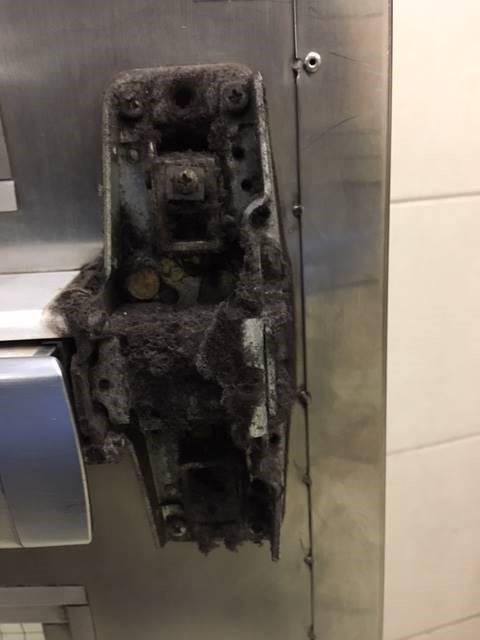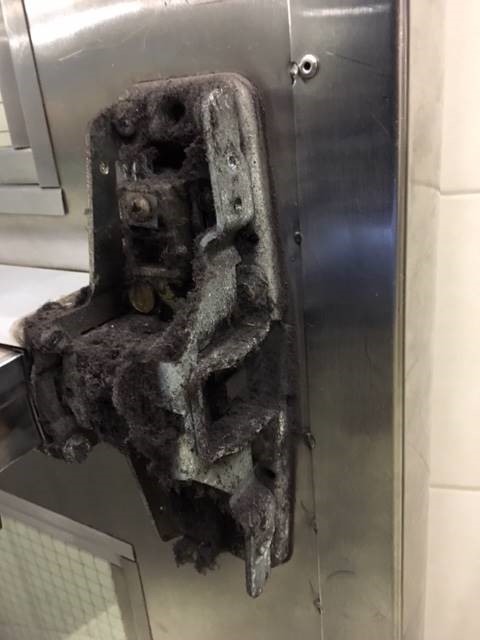I’m very curious to know what happened here. I’ve never seen anything quite like it. Any ideas?
Clues:
- The door leads to the subway system.
- After cleaning the internal parts of the panic hardware, the parts weren’t corroded or damaged.
Thanks to Todd Farrell of Trillium Architectural Products for the photos!
You need to login or register to bookmark/favorite this content.







Mold?
Car pollution?
Been there fifty years and just pulled in fifty years of gunk?
Hvac vent or similar blowing on to it??
I’m not a regular subway user but aren’t there huge drafts through there as the trains come and go? It seems like the device parts are acting as an air filter and catching all the airborne fibers and dust that get forced through the openings in the door face.
Are the hardware mortise holes serving as an HVAC air intake?
sprayed with too much lube
Ok other guess is
Debris/ gunk, being pulled from the other side of the door, into the hardware mechanism??
Looks like a build up of forklift brake dust.
The subway builds up static electricity in the air (assuming it is an electric power subway). The head being steel becomes magnetic and attracts every piece of metal dust in the air.
brake dust from the trains and little bit of oil
I am going to assume this was working and the cover was pulled off for some reason divulging the accumulated dust/dirt.
I suspect there is a path for air to blow thru this assembly, Dirty Subway Air. Thru the years the dirt and grime accumulated.
Any other ideas??
Cheers.
I’m wondering if a small electrical charge is being created between the stainless steel door and the hardware metal through electrolysis. Or, this is an electrified device and a negative charge is being applied to the metal and thus attracting the dust. This is very similar to dry powder coating.
it is caused by wind and or building fans pulling air through the cover. they may have sprayed it with wd-40 or another type of lube and that will catch dust or lint and build up like that. the best way to clean it is with carb cleaner. and not oil any of the parts except the latch bolt.
This door must have had pretty good seals or stops. The only way for the air to equalize was through the keyhole and the air was always sucking into the interior. There are generally systems that pull dirty air out of the subway and it has to be replaced from somewhere. There was a differential at this door. I am betting that the key never worked very well or was serviced monthly.
The only thing I can think is that maybe there’s negative pressure on the other side of the door.
Wow. Whatever it is, I would not touch it without hazmat garb. Appears to me like a chemical reaction. I noted that damage seems to impact the steel parts, while the aluminum parts are relatively unimpacted. Note also that the door is stainless steel which would further indicate that the space houses some kind of process.
Something sugary and sticky must have gotten spilled on the device. The surface was probably cleaned but everything under the cover festered for a while, hence the mold. That’s pretty disgusting.
I saw something similar in a fleet car at a company I used to work for. Someone spilled a large drink in the backseat and, instead of cleaning it up, they let it soak in and mold started to grow. It looked pretty similar to the device in your pictures. I’m sure I could probably find some old food in the back of the company fridge that doesn’t look much better. 🙁
I would see this in prisons all the time. It’s clothing fibers being forces through any opening air current can find as building pressures try to equalize throughout the structure. The fibers get stuck to wet lubricants. Previous maintenance staff in my facility would use WD40 in the mogul cylinder keyways too causing clumps of white cotton to build up inside. I first thought the inmates where trying to jamb the lock with toothpaste until I saw this effect in all 40 dorms.
Looks like mold but it is more likely carbon dust from the electric subway trains.
Maybe the “suede” look will catch on as a new finish at Allegion ?
I missed the subway comment. A subway train can produce high stacking pressure as it moves thorough the tunnel. If it finds a hole, they air will escape, along with any dust, debris and carbon in the atmosphere which will be deposited on the edges and other things though which the air infiltrates. Ive not seen it like this, but you never know.
Is it a buildup of soot coming from the subway system? I understand that several systems have high soot levels because, while the subway trains are electric, the maintenance trains are diesel fueled and give off black carbon soot.
So, we’ve all heard of software viruses, well…
I see that the carbon steel parts have the stuff, but not the aluminum parts of the device nor the stainless skins on the frame and door. My guess is that there’s some sort of cathodic process happening due to the generating of a negative electrostatic charge in the door, attracting positively charged particles to the carbon steel cathode (older continuous-duty solenoid? Maybe lose the solenoid and use a motor?).
Any analysis of the particles? I’m guessing they’re metallic, maybe due to friction from the trains going by — wheels on rails, power pickup on the third rail? If I’m close here, then to stop the process maybe try grounding the door assembly, and then set up an alternate negative pole — maybe a deliberately-charged air filtration system to attract the stuff? Whole lot of ‘maybe’s’ here…and a wild guess.
Cool puzzle.
I would speculate that the subway ventilation system pressurizes all the exit doors. The holes in the doors where the air can escape becomes a funnel for every particle of dirt, human skin cells, and steel dust floating around. The exit device grease keeps there. I’ve found that the exterior doors are usually the “fuzziest” although gasketed machine rooms with generators or equipment with moving parts creating more steel dust are also good “fuzzy” factories.
I would guess that the perimeter seals would also collect these particles, but they have no grease and get wiped down more often.
Perhaps there is someone who can tell us precisely what generates subway dust besides human skin cells. I think the brakes and rotors and wheels grinding on the track creates the majority of the steel dust. https://washington-dc-metro.com/2011/05/03/subway-dust-may-trigger-lung-damage/
Since the frames and doors are stainless this is most likely a food processing plant. I’ve seen this before in food processing facilities that use some chemicals that eat concrete and metal and they don’t even have to spray it directly on the surface, fumes over time dissolve the material.
Wow, that is a weird one. I would tend to agree with the posters saying it is due to air depositing material from the train side, but to see it all over inside the cover seems very strange- almost as if whatever lubricant was used on the device attracted the dark colored stuff. It also appears that there is some whitish corrosion or deposit on the steel as well, and then the darker air-borne material inside, so maybe there is more than one thing going on here. The idea of some sort of galvanic or electronic/static issue seems at least possible, but I would expect some damage to the mechanism as a result.
The fact that it worked perfectly after being cleaned up draws my thinking back to the “oily-air-deposit” line of thinking.
Very odd indeed.